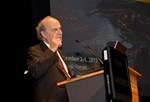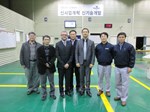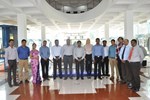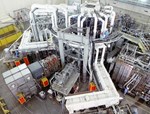Good news from the energy front is not all that frequent. However at MIIFED 2013 in Monaco last week, Pierre Gadonneix had some to share. "The good news," said the president of the World Energy Council in his closing address, "is that the world's energy resources are sufficient to feed mankind's growing appetite."
The world energy landscape has undergone considerable change and the energy map has been redrawn. "Peak oil" is now a thing of the past. "There is no shortage of fossil fuels in sight," assured Gadonneix. "The continued discovery of new resources and the emergence of new technologies [...] have already significantly increased available resources and this trend could continue."
Over the past three years, major production and consumption flows have been altered. Thanks to oil and shale gas exploitation, the US is now on the road of self-sufficiency. Last November, for the first time in decades, it has exported more barrels of oil than it imported. The country has now overtaken Saudi Arabia as the world's biggest oil producer—something that was unthinkable one decade ago ...
In parallel the Middle East, which for almost one century was almost exclusively an exporter, has recently become a key consumer. And Asia, with its huge, hungry and fast-growing markets, is already "the key driver for fixing the world market price of energy commodities like oil, gas and coal."
"There are some myths that need to be revisited," warned Gadonneix. The imminence of peak oil, long taken for granted, is one. The potential contribution of renewables in the future energy mix is another. "Although the contribution of renewables will increase from 15 percent today [including hydropower] to 20-25 percent in 2050, there will still be a significant increase in fossil fuel production and consumption." It is clear that the contribution of renewables will not be enough to meet the world's hunger for energy.
As worldwide energy demand is likely to rise 36 percent by 2030 and to double by 2050 (with 93 percent of growth driven by emerging countries) and as demand for electricity will have doubled between 2000 and 2030, greenhouse gas emissions are not on the right track to meet the objective of limiting global warming to an increase of 2 °C, according to Gadonneix.
"In all scenarios developed by the World Energy Council or the International Energy Agency (IEA), emissions are increasing at a rate which is more coherent with four degrees of global warming than with two."
The energy " trilemma"—energy security, energy accessibility and environmental sustainability— will not be solved easily. "There's a clear need for better governance at both national and international levels," insists Gadonneix. "The world needs improved coordination on energy and climate issues in order to drive the patchwork of national policies towards the ultimate sustainability goal."
Central to the preoccupations of the president of the World Energy Council and former president of the French utility firm EDF (2004-2009) is the necessity to extend this global governance to safety for all sources of energy, and not only nuclear. "In the post-Fukushima world," he says, "this goal is achievable with reasonable effort by building on existing institutions.
ITER, in his view, is "a very good example of long-term vision and international cooperation." The project "truly shows that securing tomorrow's energy demands vision and investment now."
The Forschungszentrum Jülich research center in Germany reported last week on the shutdown of the TEXTOR tokamak after thirty years of operation. Jülich plasma physicists are now refocusing their efforts on investigating materials science and the challenges associated with continuous operation. We reproduce the full press release below.
Jülich, 5 December 2013—For thirty years, the results produced at Jülich's large-scale device TEXTOR have considerably advanced international fusion research. Yesterday at 18:00, a plasma discharge provided science with data for the very last time. Now that TEXTOR has been shut down, Jülich fusion research will turn its full attention to material issues and problems associated with continuous operation—and thus to the remaining hurdles on the way towards environmentally friendly and safe power plants generating energy based on the principle of the sun's fire.
"TEXTOR was immensely important in helping us to gain the knowledge that we have today of how fusion works," says Prof. Ulrich Samm, director at the Institute of Energy and Climate Research/Plasma Physics. If it proves possible to harness nuclear fusion—the fusion of atomic nuclei—to generate energy, then mankind will have access to an almost inexhaustible source of energy.
Since 1983, the Tokamak EXperiment for Technology Oriented Research (TEXTOR for short) has provided a whole series of scientifically outstanding results. For example, in 1989, boronization was developed and tested at Jülich as a method of coating vacuum vessel walls, and subsequently implemented by all other fusion experiments throughout the world. In 1991, Jülich scientists implemented controlled radiation cooling at TEXTOR. This method allows the hot hydrogen plasma of up to 10 million degrees Celsius to be reduced to a temperature at the edge regions that the wall materials can withstand. Recently, tests and optimizations of wall elements made of tungsten contributed to the decision to use this metal in the international fusion reactor ITER, which is scheduled to go into operation in the south of France by 2020.
TEXTOR was primarily built and used to study the interactions between plasma and the vacuum vessel wall. With respect to plasma temperature and plasma density, the experiment was unable to reproduce the real operating conditions of a fusion power plant. TEXTOR was too small to do so. The device was also not suitable for exploring the problems associated with continuous operation. "And yet continuous operation is the remaining hurdle on the way towards a fusion power plant for electricity generation. Now that TEXTOR has been shut down, we will direct our full attention to overcoming this challenge," says Samm.
Jülich plasma physicists emphasized the new focus on the altered issues with a symbolic act. Yesterday, after TEXTOR's last plasma discharge, they pushed a button in its control centre: the control monitors then no longer showed the interior of the TEXTOR vacuum vessel, but images of the Jülich plasma generator PSI and other materials research set-ups. After all, the continuous operation of a fusion power plant will only be possible if suitable materials are available.
Jülich fusion researchers have been preparing for the shift in their research priorities for quite a while. For example, in March of this year, Forschungszentrum Jülich appointed Prof. Christian Linsmeier from the Max Planck Institute for Plasma Physics, Garching—an acclaimed materials researcher—second director of the subinstitute. In addition, the plasma physicists have been expanding their research activities outside of TEXTOR: at the very end, only 15 percent of the laboratory space was dedicated to the large-scale device. Jülich fusion researchers will also continue to work at international and European installations, particularly at the largest existing fusion experiment—JET in the UK. In addition to ITER and DEMO, the reactor generation after ITER, they are putting their expertise to good use at the Wendelstein 7-X stellarator in Greifswald—an alternative reactor type.
The dismantling of TEXTOR, which contains some 600 tonnes of metal, will take more than three years.
Taking advantage of the presence of representatives from all ITER Domestic Agencies at the MIIFED 2013 conference held in Monaco last week, the ITER Organization was able to conclude five Procurement Arrangements and one Memorandum of Understanding.
On Monday 2 December, a Procurement Arrangement was signed with the US Domestic Agency for the development of ITER's pellet injection system, which will fuel the plasma by firing frozen deuterium and tritium pellets. The pellet injection system is also capable of controlling the frequency of Edge Localized Modes (ELMs) by injecting smaller pellets of frozen deuterium at the edge of the plasma at high rates.
The Oak Ridge National Laboratory, with a long history of success in the development of pellet injection systems for the JET tokamak (UK), TFTR (US), the DIII-D tokamak (US) and other fusion devices, will collaborate with US ITER. To meet the challenging requirements for the ITER pellet injection system, which far exceed those for any other system in operation, ORNL has launched an R&D program to develop an ITER-scale pellet injection system prototype incorporating all the key technologies necessary for the ITER system. A prototype test program using supercritical helium cooling from the Spallation Neutron Source at ORNL is planned as part of the Procurement Arrangement.
The Toroidal Field Coil Structure Procurement Arrangement was signed on Tuesday 3 December by three parties—the ITER Organization, the Japanese Domestic Agency and the European Domestic Agency. Each of ITER's 19 toroidal field magnets (18 for operation, plus one spare) is enclosed in a thick, "D" shaped steel structure called the toroidal field coil case. Procurement of the 19 coil cases is the responsibility of Japan; however, as part of the agreement to site the ITER Project in Europe, ten of the coil cases will be paid for by Europe.
And finally three Procurement Arrangements dedicated to ITER's electrical power distribution systems were signed on 3 December with the European Domestic Agency: Steady State Electrical Network (SSEN) and Pulsed Power Electrical Network (PPEN) Installation; Emergency Power Supply; and the manufacturing and delivery of SSEN Components.
For both the European Domestic Agency and ITER's Electrical Engineering Division, these three signatures are major milestones because "now everything is ready for the fabrication and installation of ITER's two electrical networks," stressed Division Head Ivone Benfatto following the signatures. "In particular, the SSEN must be ready by 2016 to supply the power for the commissioning of ITER's major plant systems."
A Memorandum of Understanding was also concluded during MIIFED 2013 for the common manufacture of ITER's 44 port plugs. Japan was the second Domestic Agency to sign the Memorandum following the signature of India in July. The objective is to have the ITER Domestic Agencies involved in port plug procurement contract with one single manufacturer, in order to benefit from the advantage of having one standard for design, quality assurance, and qualification and manufacturing methods.
|
At the end of November, Korea became the first Domestic Agency to complete the production of niobium-tin (Nb3Sn) strand for ITER's toroidal field conductors.
Nb3Sn strand is the basic building block of ITER's large magnets, the key element that makes them superconducting. Superconductivity is essential to pursuing fusion energy generation because superconductors consume less power and are cheaper to operate than conventional counterparts, while carrying higher current and producing stronger magnetic field. Six Domestic Agencies (China, Europe, Japan, Korea, Russia and the US) are responsible for procuring over 400 tons of toroidal field conductor for ITER.
The Korean milestone was validated late November with the approval the Authorization To Proceed Points (ATPPs) by the ITER Organization for the final batch of strand billets. (A billet is the smallest traceable production unit of strand.) In order to assure quality and full traceability for ITER, the manufacturing information and test results of every billet are registered electronically in the Conductor Database, and then reviewed by the procuring Domestic Agency and finally given approval by the ITER Organization to proceed to next step. Remarkably, fully 2,038 individual Korean billets have passed thorough review by the Korean Domestic Agency and ITER.
The Korean share of toroidal field strand procurement amounts to 93 tonnes (20 percent of toroidal field strands). The manufacturing contract was awarded to Kiswire Advanced Technology (KAT), which began producing in 2009. To have completed the manufacturing in four years is an impressive rate of production considering that, worldwide, the production of Nb3Sn strand before ITER did not exceed 15 tonnes per year.
"The toroidal field conductor Procurement Arrangement with Korea is a good example of an ITER success story," states Arnaud Devred, who is responsible for the Superconductor Systems & Auxiliaries at ITER. "The close collaboration of the Korean Domestic Agency and the ITER Organization to monitor execution enabled both parties to address production issues in a timely and effective manner. This milestone is all the more remarkable in that the strand supplier KAT was new to the business when the contract was launched, but managed to adapt to the world-class standards imposed by the Procurement Arrangement."
The head of the Indian Domestic Agency, Shishir P. Deshpande, has announced that the contract for the final design and procurement of ITER's component cooling water, chilled water, and heat rejection systems has been awarded to the Indian company Larsen & Toubro (L&T) Ltd, the company also retained for the manufacture of the ITER cryostat.
Together with the tokamak cooling water system (procured by the US), the component cooling water, chilled water and the heat rejection systems will remove the enormous amounts of heat generated by the tokamak and its auxiliary systems.
This important milestone is a direct result of the diligence, cooperative attitude and flexibility of the Indian cooling water team, supported by the ITER Cooling Water Section. Following the contract award Giovanni Dell Orco, Cooling Water Section Leader, congratulated both groups: "This milestone is indeed a major accomplishment and a tribute to the hard work and perseverance of you all."
Larsen & Toubro is one of the largest and most respected companies in India's private sector and among the top five engineering, construction and manufacturing companies in the world. The company will execute the cooling water contract from its Chennai office in southern India.
From 25-30 November, ITER cooling water staff attended kick-off meetings held in Chennai and Ahmedabad. A significant result of those meetings was agreement on an aggressive schedule to accelerate delivery of the buried cooling water piping on site, whose installation is due to begin next year.
Tensions rose in the US Department of Energy's Princeton Plasma Physics Laboratory (PPPL) as the seconds counted down. At stake was the first crucial test of a high-powered mixture of fuel for producing fusion energy. As the control-room clock reached "zero," a flash of light on a closed-circuit television monitor marked a historic achievement: a world-record burst of more than 3 million watts of fusion energy—enough to momentarily light some 3,000 homes—fueled by the new high-powered mixture. The time was 11:08 p.m. on Thursday, 9 December 1993.
"There was a tremendous amount of cheering and clapping," recalled PPPL physicist Rich Hawryluk, who headed the Tokamak Fusion Test Reactor (TFTR), the huge magnetic fusion facility that produced the historic power. "People had been on pins and needles for a long time and finally it all came together." It did so again the very next day when TFTR shattered the mark by creating more than six million watts of fusion energy.
The achievements generated headlines around the world and laid the foundation for the development of fusion energy in facilities such as ITER to demonstrate the feasibility of fusion power. The results delivered "important scientific confirmation of the path we are taking toward ITER," said physicist Ed Synakowski, a PPPL diagnostics expert during the experiments and now associate director of the Office of Science for Fusion Energy Sciences at DOE. "I felt an important shift in the understanding of fusion's likely reality with those experiments."
The breakthroughs proved the practicality of combining equal amounts of the hydrogen isotopes deuterium and its radioactive cousin tritium—the same combination that will be used in ITER and future fusion power plants—to form the superhot, charged plasma gas that fuels fusion reactions. The deuterium-tritium (D-T) mix produced some 150 times more power than a reaction fueled solely by deuterium, long the stand-alone ingredient in tokamak experiments, or "shots."
"This was the first test with equal parts D-T and it was technically quite challenging," said Michael Zarnstorff, a task-force leader during the experiments and now deputy director for research at PPPL. "What we did marked a huge advance in integrating tritium into fusion facilities."
Gained insights included precise measurement of the confinement and loss of alpha particles that fusion reactions release along with energetic neutrons. Good confinement of the alpha particles is critically important since they are to serve as the primary means of heating the plasma in ITER, and thereby producing a self-sustaining fusion reaction, or "burning plasma."
|








